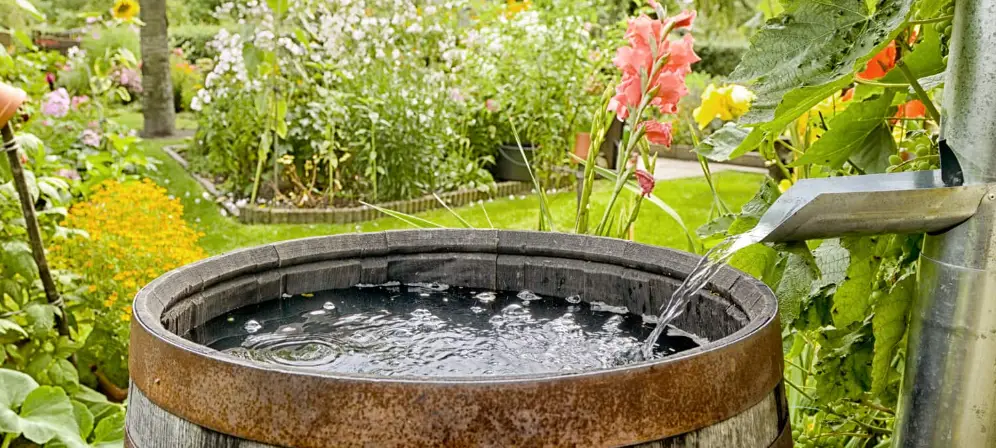
How to Collect Rainwater For Plants? Rainwater is the perfect natural resource for irrigating your home plants. Given that it’s a free, readily-available resource, you should take every opportunity to take advantage of it.
Read on to discover more about how you can use rainwater to irrigate your indoor plants. Rainwater is a great alternative to tap water when it comes to watering houseplants and other indoor plants.
With rainwater as a source of irrigation, your plants can thrive even during the dry summer months. Read on to find out more about collecting rain for indoor houseplants, and how you can do it at home
Harvesting rainwater from a roof or downspout
Harvesting rainwater for plants is a simple and free way to get water for your plants. You can buy rain barrels or convert a container you already have. The best material to use for a rain barrel is non-clear plastic.
A trash can, a used food barrel from a restaurant, or a plastic drum that holds non-harsh chemical products are all good options. Just make sure to leave an opening for the downspout.
The first step is cleaning the rain barrel. You can clean the rain barrel with a solution of chlorine bleach, castile soap, vinegar, or lemon juice. This solution helps remove sediment and disinfect the container.
Using a rain barrel
There are a number of benefits to using a rain barrel to collect rainwater for your plants. First of all, it will help you conserve water. It is estimated that 40% of the water used in a typical household goes to outdoor use.
Furthermore, it will help you save water during periods of water shortage and water restrictions. In addition, it will reduce your ecological footprint by reducing the amount of runoff that carries sediments and contaminants into streams and rivers. In fact, the practice of rain barrel harvesting goes back to ancient civilizations, when people collected rainwater in cisterns.
To use a rain barrel, first, you need to install a hose to divert the water. You can get this hose from a hardware store or even rent one from a bulk food company. A hose attached to a rain barrel should have a filter that will keep debris and pollutants from contaminating the water.
Also, remember to clean your barrel at least once a year. If you have a rain barrel that is a few years old, you may want to install a first-flush diverter.
Using a rain garden
There are several advantages to using a rain garden to collect rainwater for your plants. First, it can improve the quality of the water in your yard, reduce the risk of flooding, and attract wildlife.
Additionally, a rain garden reduces the number of pollutants that enter the storm drain system. It also improves water quality by filtering pollutants and recharging the groundwater.
In order to use rain gardens effectively, the catchment basin must be deep enough. To determine the depth of the catchment basin, you need to divide the total area of your garden by its cubic footage. Then, multiply this number by 12 to get the depth of the basin.

Using a rain garden without a roof or downspout
When using a rain garden without a roof or a downspout to collect rainwater for your plants, keep in mind that the soil needs to be aerated so that excess water can drain safely. To do this, dig holes in the subsoil with a fork.
This helps water to infiltrate and benefit your plants. In addition, you need to be sure to keep the water away from a neighboring home, sidewalk, or concrete slab foundation.
A rain garden is also an excellent way to protect your soil from erosion and stormwater runoff. It channels stormwater runoff away from your property and improves drainage in your yard.
It is also a great opportunity to plant native plants that thrive in wet soil. In addition to providing beautiful landscaping, these plants will also attract insects like bees, butterflies, and birds.
Pitfalls of rainwater harvesting
There are many advantages to rainwater harvesting for plants. Harvesting rainwater can cut your utility bills and provide water for many purposes, such as watering your plants and cleaning your house.
This method can also reduce soil erosion. Additionally, rainwater harvesting can be used to fill swimming pools and reduce the amount of water that evaporates. However, there are some risks to harvesting rainwater for plants.
First and foremost, if you do it right, you can save money on water. It is also an environment-friendly way to water your plants. There are many advantages to rainwater harvesting and some disadvantages.
It is important to know the risks associated with it and make sure you understand the process before you get started.
Conclusion
For many years, we have been harvesting rainwater off the roof of our house. Rainwater is a great way to keep our family hydrated throughout the summer (or any time of year for that matter) and it’s also beneficial for our plants. It may seem like a bit of a challenge to collect this water, but it doesn’t have to be!
You can use a variety of different methods to make the most of rainwater, whether you live in a dry area or where it rains frequently. In order to start harvesting rainwater, it’s important to know where it’ll likely fall. Since rainfall varies according to location, it’s important to find out exactly where you live and where you’ll likely get your water.
You can do this by using a rain gauge or checking the weather forecast. Once you know where to collect water, you can make your own container or purchase one that’s ready to go.
Thanks for stopping by serconline.
Useful links:
https://serconline.org/knowledge-base/
https://serconline.org/product-reviews/
https://serconline.org/about-us/
https://serconline.org/contact-us/

